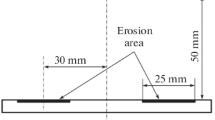Abstract
A one-dimensional model describing the diffusion of intrinsic defects in lead zirconate titanate (LZT) films of nonstoichiometric composition during their high-temperature treatment is proposed. The model includes the diffusion of vacancies by lead and oxygen, the formation and decay of their associates, interaction with extensive defects (dislocations in LZT films and the near-surface layer), interstitial inclusions, and LZT film contact with air leading to lead oxide evaporation from LZT film and its saturation by oxygen. The dependences of LZT film composition on the temperature and time of treatment are calculated. The possibility the concentration’s oversaturation by lead in a near-surface layer of LZT film, which can lead to the release of lead oxide, is shown.
Similar content being viewed by others
References
Physics of Ferroelectrics: A Modern Perspective, Rabe, K.M., Ahn, Ch.H., and Triscone, J.-M., Eds., Berlin: Springer-Verlag, 2007. Translated under the title Fizika segnetoelektrikov: Sovremennyi vzglyad, Moscow: BINOM Laboratoriya Znanii, 2011
Fedorov, K.A., Afanas’ev, V.P., Afanas’ev, P.V., and Petrov, A.A., Investigation of short-circuit photocurrent in capacitor structures based on heterophase films of lead zirconate titanate, Vestn. Ryazan. Gos. Radiotekh. Univ., 2012, no. 4, issue 42, part 2, pp. 43–47.
Vorotilov, K.A. and Sigov, A.S., Ferroelectric memory devices: Advanced technologies and materials, Nano-Mikrosist. Tekh., 2008, no. 10, pp. 30–42.
Zhigalina, O.M., Vorotilov, K.A., Khmelenin, D.N., and Sigov, A.S., Structural features of lead zirconate titanate films formed by chemical precipitation from solutions with different lead concentrations, Nano-Mikrosist. Tekh., 2008, no. 11, pp. 17–22.
Tentilova, I.Yu., Kukushkin, S.A., Kaptelov, E.Yu., Pronin, I.P., and Ugolkov, V.L., Peculiarities of crystallization of thin ferroelectric films of lead zirconate titanate, Tech. Phys. Lett., 2011, vol. 37, no. 2, pp. 163–165.
Mukhin, N.V., Fedorov, K.A., and Chigirev, D.A., Physicalchemical features of nanostructured heterophase ferroelectric films for memory elements with optical reading, in Abstracts of Papers of the Second Nanotechnology International Forum “Rusnanotech-2009,” Moscow, Russia, October 6–9, 2009, Moscow, 2009.
Afanas’ev, V.P., Mukhin, N.V., and Chigirev, D.A., Effect of heat treatment on the properties of thin films of lead zirconate titanate deposited by radio-frequency magnetron sputtering, Izv. Vyssh. Uchebn. Zaved., Radioelektron., 2011, no. 6, pp. 79–84.
Mukhin, N.V., Phase analysis of the processes of preparation of zirconium, titanium, and lead oxides, Izv. Vyssh. Uchebn. Zaved., Radioelektron., 2012, no. 5, pp. 88–96.
Kreger, F.A., The Chemistry of Imperfect Crystals, Amsterdam, The Netherlands: North-Holland, 1964. Translated under the title Khimiya nesovershennykh kristallov, Moscow: Mir, 1969.
Prisedskii, V.V., Nestekhiometricheskie segnetoelektriki AIIBIVO3. Monografiya (Stoichiometric Ferroelectrics AIIBIVO3: A Monograph), Donetsk: Noulidzh, 2011.
Bokshtein, B.S., Kopetskii, Ch.V., and Shvindlerman, L.S., Termodinamika i kinetika granits zeren v metallakh (Thermodynamics and Kinetics of Grain Boundaries in Metals), Moscow: Metallurgiya, 1986.
Mukhin, N.V., Calculation of grain boundary segregation and the growth kinetics of precipitates of the new phase from the solid solution, Certificate of State Registration of Computer Programs no. 2013612557 (March 5, 2013).
Sanjeev, A. and Ramesh, R., Point defect chemistry of metal oxide heterostructures, Annu. Rev. Mater. Res., 1998, vol. 28, pp. 463–499.
Zakis, Yu.R., Kantorovich, L.N., Kotomin, E.A., Kuzovkov, V.N., Tale, I.A., and Shlyuger, A.I., Modeli protsessov v shirokoshchelevykh tverdykh telakh s defektami (Models of Processes in Wide-Band-Gap Solids with Defects), Riga: Znanie, 1991.
Holman, R. and Fulrath, R.M., Intrinsic nonstoichiometry in the lead-zirconate lead-titanate system determined by Knudsen effusion, J. Appl. Phys., 1973, vol. 44, pp. 5227–5231.
Cancarevic, M., Zinkevich, M., and Aldinger, F., Thermodynamic assessment of the PZT system, J. Ceram. Soc. Jpn., 2006, vol. 114, no. 11, pp. 937–946.
Prisedskii, V.V., Klevtsova, L.G., and Klimov, V.V., Mechanism and kinetics of reaction diffusion in the processes of formation of lead zirconate and lead titanate, Izv. Akad. Nauk SSSR, Neorg. Mater., 1974, vol. 10, no. 12, pp. 2166–2172.
Prisedskii, V.V., Gusakova, L.G., and Klimov, V.V., Kinetics of the initial stage of sintering of lead zirconate titanate ceramics, Izv. Akad. Nauk SSSR, Neorg. Mater., 1976, vol. 12, no. 11, pp. 1995–1999.
Author information
Authors and Affiliations
Corresponding author
Additional information
Original Russian Text © N.V. Mukhin, 2014, published in Fizika i Khimiya Stekla.
Rights and permissions
About this article
Cite this article
Mukhin, N.V. Diffusion model of intrinsic defects in lead zirconate titanate films on heat treatment in air. Glass Phys Chem 40, 238–242 (2014). https://doi.org/10.1134/S108765961402014X
Received:
Published:
Issue Date:
DOI: https://doi.org/10.1134/S108765961402014X



